May 15, 2018
The distance report provides a unique view of your geographic data. The report helps users understand how distance from a location impacts search ad performance. This data can be used to adjust targeting strategy, planning new initiatives, and understanding the effective reach of ads.
If you are using location extensions but not utilizing this report, you are missing out on a valuable data set. This report is especially valuable for multi-location businesses and those that offer local services, such as storage, home services, and health care.
What is the distance report?
The distance report provides data segmented by the distance from your location extensions. Based on the proximity the searcher will be bucketed by radius segment. This means you can’t get hyper specific with the radii, but it will provide you more information than you knew before.
In this article we’ll answer a couple of example questions that you can carry over to your own account. We’ll focus on analyzing clicks behavior by distance and creating a model of how distance impacts overall performance.
The data at each distance interval is inclusive. This means data for ads shown within 10 miles of the location includes data for ads shown within one mile and five miles. This may seem like an unnecessary detail but will be useful once we get to work.
Where do most clicks occur?
Defining the distances at which clicks, or any metric, occur allows us to get more specific with our targeting. Are we targeting too broadly, should you be focused on smaller radii? Calculating the percentage of a metric by radius helps us define your effective range. This enables us to answer questions such as “should we be targeting a smaller area or a larger area?”
In this example our account structure has segmented locations into different campaigns. Downloading the distance report with the campaign segment offered a breakdown of performance for each radius interval and campaign. With a little cleanup we can covert this into performance by distance and location.
Once we have that, we can reformat the data to get a percentage of clicks within each radius. Simply divide the clicks at a given distance by the total clicks for a location or campaign and we’ll have a number for the percentage of clicks falling within a given range.
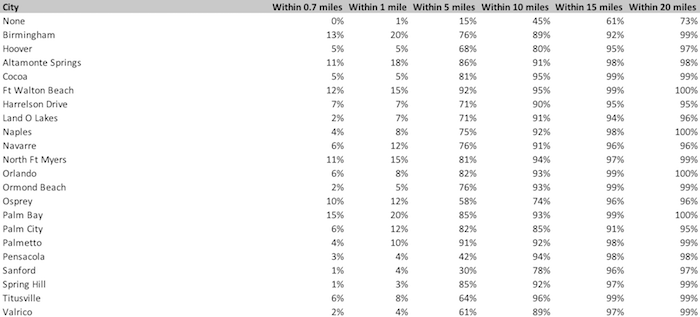
This is a lot of data though and not easily digestible. We can strip this down by adding helper columns. We’ll use a series of if functions to define where we hit 80% of our click volume and 90% of our click volume.
We can then take the data from those two columns and count the number of occurrences of each.
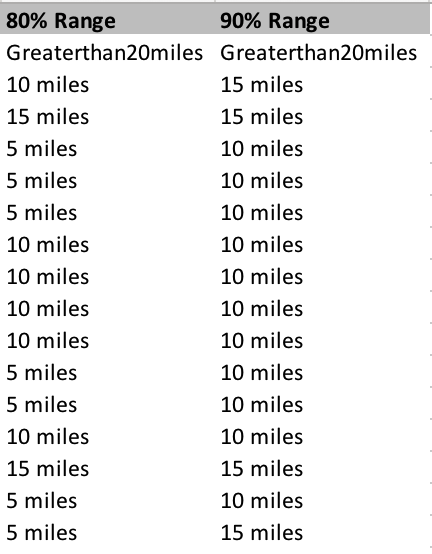
Based on this data, clicks are most likely to fall within 5 miles. If we are looking to extend our reach to cover 90% of the clicks we should move out to 10 miles.
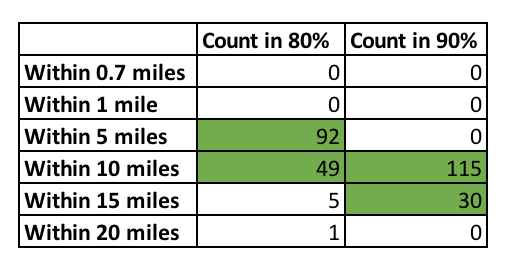
We can do this with any metric or any segments you’d like to choose. We can also better address questions like “is five miles a valuable target or is it too far away?”
This tells us what areas to focus on but how is efficiency impacted by distance from a business location?
How does distance impact performance?
If the data wrangling in the last section stressed you out, don’t worry. This section is more straightforward.
In the last example we saw that an additional 10% of our clicks came in the five to ten mile range. That percentage tells us there are gains, but how many total clicks and conversions is that? Is ad performance steady across those distances?
Using the report as is, we can plot a few graphs to get an idea of performance by distance.
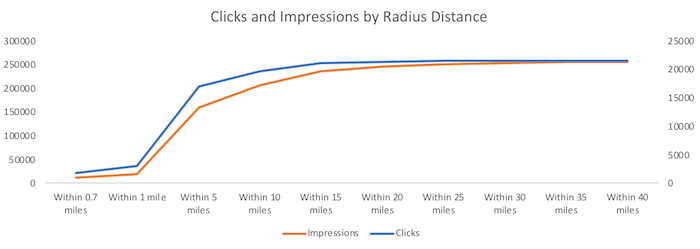
We can also breakdown the likelihood of an impression generating a click and a click generating a conversion.
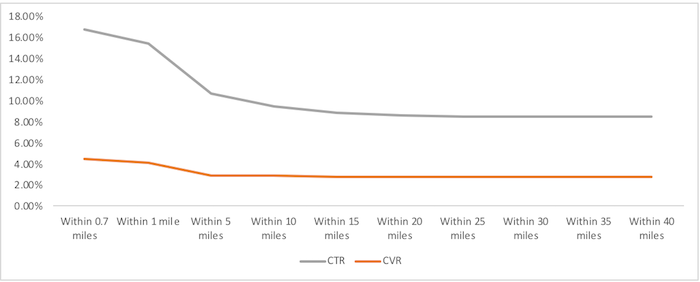
In this example click through rate nearly halves from 1 mile to 10 miles. Conversion rates also drop considerably meaning less effective ads. It’s safe to say that distance does have an impact on ad performance and we should accommodate for it. By extending our reach we definitely won’t see performance increase at the same rate.
If you are wondering if it’s effective to keep advertising within certain distances, we can take advantage of the inclusiveness of each range. We can calculate the marginal CPA from five miles to ten miles by taking the difference in cost and conversions, divide cost by conversions and get the CPA for this range.

As opposed to a blended CPA, this number tells us how much it costs for a conversion as we move away from our business location. Depending on our goals and ambitions this data can steer us towards expanding or refining our reach. Depending on other metrics like impression share and CPA, it may be more beneficial to be more aggressive in the tight radii and back of slightly as distance increase.
Conclusion
We covered two broad examples for using the distance report. Through this report advertisers can more readily address questions of range and better assess the impact of distance on ad performance.
The report is useful on its own and is made more accessible through modifications and modifying the data to line up with your business needs.